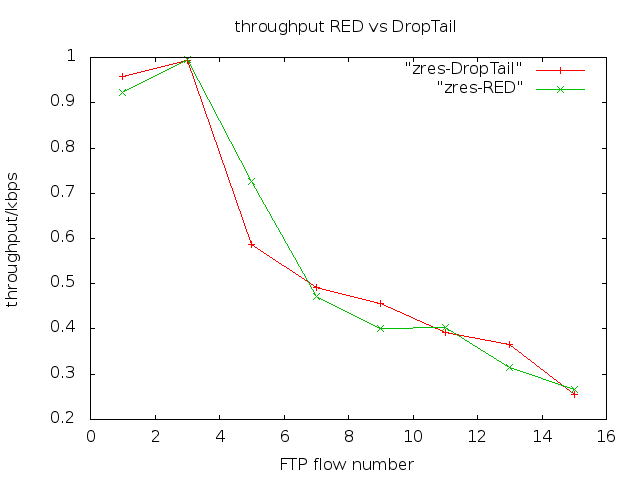NS 2.35 柯志亨书-实验4笔记-随机数产生-参数化批处理
Tcl代码:
# Kezhiheng, experiment 4, test RNG, 3 tcp flow
# Usage: ns xx.tcl flowno seed
if {$argc!=3} {
puts "Usage: ns xx.tcl flowno_ seed_ queue_"
puts "queue_ DropTail or RED"
exit
}
set par1 [lindex $argv 0]
set par2 [lindex $argv 1]
set par3 [lindex $argv 2]
#Create a simulator object
set ns [new Simulator]
set tracefd [open resultdata/zout-$par3-$par1-$par2.tr w]
$ns trace-all $tracefd
set namtracefd [open out.nam w]
$ns namtrace-all $namtracefd
proc finish {} {
global ns tracefd namtracefd
$ns flush-trace
close $tracefd
close $namtracefd
# exec nam out.nam &
exit 0
}
# 3 TCP flow
set nflow $par1
# Set router nodes
set r1 [$ns node]
set r2 [$ns node]
$ns duplex-link $r1 $r2 1Mb 10ms $par3
$ns queue-limit $r1 $r2 10
# Set TCP src, dest, link
for {set i 1} {$i<=$nflow} {incr i} {
set s($i) [$ns node]
set d($i) [$ns node]
$ns duplex-link $s($i) $r1 10Mb 1ms DropTail
$ns duplex-link $r2 $d($i) 10Mb 1ms DropTail
}
# Set TCP agent and FTP traffic
for {set i 1} {$i<=$nflow} {incr i} {
set tcp($i) [new Agent/TCP]
set sink($i) [new Agent/TCPSink]
$ns attach-agent $s($i) $tcp($i)
$ns attach-agent $d($i) $sink($i)
$ns connect $tcp($i) $sink($i)
set ftp($i) [new Application/FTP]
$ftp($i) attach-agent $tcp($i)
$ftp($i) set type_ FTP
}
set rng [new RNG]
$rng seed $par2
set rvStart [new RandomVariable/Uniform]
$rvStart use-rng $rng
$rvStart set min_ 0.0
$rvStart set max_ 1.0
for {set i 1} {$i<=$nflow} {incr i} {
set startT($i) [expr [$rvStart value]]
# puts "startT($i) $startT($i) sec"
set endT($i) [expr ($startT($i)+5)]
# puts "endT($i) $endT($i) sec"
$ns at $startT($i) "$ftp($i) start"
$ns at $endT($i) "$ftp($i) stop"
}
$ns at 7.0 "finish"
$ns run
从tr提取吞吐量数据的awk代码:
# Measure the throughput by the trace file
BEGIN{
# program initialize
init = 0;
startT=0;
endT=0;
}
{
action = $1;
time = $2;
from = $3;
to = $4;
type = $5;
pktsize = $6;
flow_id = $8;
src = $9;
dst = $10;
seq_no = $11;
packet_id = $12;
# Record pkttype=tcp, action=r, time 1s~5s
if(action=="r" && type=="tcp" && time>=1.0 && time<=5.0 && \
( (from==1 && to==3)||(from==1 && to==5)||(from==1 && to==7) ) )
{
if(init==0)
{
startT = time;
init = 1;
}
pkt_byte_sum += pktsize;
endT=time;
}
}
END {
# When read over, start to calculate
#printf("startT:%f,endT:%f\n",startT,endT);
#printf("pkt_byte_sum:%d\n",pkt_byte_sum);
time = endT-startT;
throughput=pkt_byte_sum * 8 / time / 1000000;
#printf("throughput:%.3f Mbps\n", throughput);
printf("%.3f\n", throughput);
}
求平均的awk代码:
# Measure the throughput by the trace file
BEGIN{
# program initialize
sum = 0;
cnt = 0;
}
{
thrpt = $1;
cnt = cnt + 1;
sum = sum + thrpt;
}
END {
# When read over, start to calculate
ave = sum/cnt;
printf("%d %.3f\n", flowno, ave);
}综合的perl代码:
#!/usr/bin/perl
#1. flowno, 1,3,5,7,9
#2. seed, 1,2,3,4,5
#3. zresult-flowno-seed, 5*5=25 files
# flow max number, should be odd
my $flowmax=15;
my $queue="DropTail";
#my $queue=RED;
for ($i=1; $i<=$flowmax; $i=$i+2)
{
print " i=$i\n";
for ($j=1; $j<=5; $j++)
{
system("ns rng_tcp.tcl $i $j $queue");
$f1="resultdata/zout-$queue-$i-$j.tr";
$f2="resultdata/zresult-$queue-$i";
system("awk -f rng_tcp.awk $f1 >> $f2");
print "j=$j\n";
}
}
#1. flowno, 1,3,5,7,9
#2. calc average
print "Start to calc average...\n";
for ($i=1; $i<=$flowmax; $i=$i+2)
{
print "i=$i\n";
$f1="resultdata/zresult-$queue-$i";
system("awk -v flowno=$i -f ave.awk $f1 >> zres-$queue");
}
绘图代码:
#!/bin/bash gnuplot -persist<<EOF set terminal gif set output "thrpt.gif" set title "throughput RED vs DropTail" set xlabel "FTP flow number" set ylabel "throughput/kbps" #unset key plot "zres-DropTail" with linespoints, "zres-RED" with linespoints EOF
RED,DropTail,的对比图,不过似乎没什么区别,还应该比较队列长度和吞吐量的关系
说明:
1、Tcl可以使用下面的代码提供参数输入:
if {$argc!=3} {
puts "Usage: ns xx.tcl flowno_ seed_ queue_"
puts "queue_ DropTail or RED"
exit
}
set par1 [lindex $argv 0]
set par2 [lindex $argv 1]
set par3 [lindex $argv 2]
View Code
2、perl代码里面可以实现tcp flow的设定,随机数的设定,queue的设定,代码:
# flow max number, should be odd my $flowmax=15; my $queue="DropTail"; #my $queue=RED;
3、由于大批量的数据结果有许多文件,可以放到文件夹中,文件夹要提前建立,tcl中open。。。不能建立文件夹
当时记得笔记:
测试了3条tcp流通过一条瓶颈链路时,链路的吞吐量
通过采用不同的随机启动时间,得到不同的试验结果,可以平均一下
################################
可完善地方:
使用shell
#!/bin/bash
ns rng_tcp.tcl
awk -f rng_tcp.awk out.tr
如果ns xxx.tcl
这句可以带参数,那么就可以在shell中,写循环测试不同数量ftp流的吞吐率了
外层循环使用ftp流的数量
内层循环使用随机数种子
###################################
xx.tcl 后面可以带参数,tcl文件里还是$argc, $argv获取
使用perl可以实现ns命令的参数变化
system("ns rng_tcp.tcl $i $j");
> < 是输入输出重定向,创建新文件
>> << 也是输入输出重定向,追加旧文件
执行流程:
ns_awk.pl : ns + awk(提取tr文件数据)
total.pl : awk(求平均)
plot.sh : 绘图
初步感受到了linux批处理的强大
######################################
下一步测试:
.将结果文件放入文件夹中,tcl路径语法
要提前建立好文件夹,下面语句不能建立文件夹
set tracefd [open resultdata/zout-$par3-$par1-$par2.tr w]
.将中间瓶颈链路的Queue机制改变,测试效果
RED vs DropTail
结果:针对不同tcp flow,两种queue策略的吞吐量没什么区别,应该比较吞吐量和平均队列长度的关系
